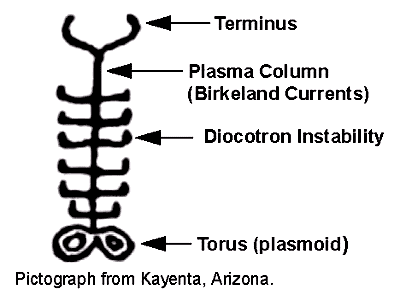I was struck by how different people interpret the same image after reading the latest offering from www.thunderbolts.info/wp/2016/04/04/divine-colors/ … Michael Armstrong sees the gods of old as planetary in origin. Others might see them differently. When it comes to colours such as blue and black he thinks in terms of Saturn expelling dust as dark as soot. He then informs his readers that Kala was one of the names applied to Saturn – a planet. Rather than black Kala was actually dark blue in hue, he tells us. The same colour was associated with Shiva. Nickanthus, he says, means 'blue throat' – another form of Shiva. Krishna, another deity of the Hindus and associated with an event bringing one age to an end and ushering in the current one, was also associated with the colour of blue. However. Krishna also has the meaning of 'the dark one' as in black (or very dark blue). Other people identify the gods with comets rather than planets – and the nuclei of comets are as black as coal. A nuclei seen in the backdrop of the blue sky may have appeared to be dark blue in hue as it is all about refraction of light as seen from the surface of the Earth.
Armstrong obtained his information from Dwardu Cardona, chapter 12 of Metamorphic Star. He was a prolific contributor to the journal Kronos and his view is that the gods were all planets – with the implication the solar system was in disarray within human memory. It was not just Saturn that had a prominent role in myth, it is alleged, but the planets Venus and Mars too (and Mercury according to some people). Lots of ink has been spent in trying to prove the Venus Tablets of Ammisaduqa refer to a time when that planet had a different orbit – not yet settled down. As Ammisaduqa lived in the second millennium BC this would imply Venus had a contrary orbit as recently as a few thousand years ago. Did it? It could equally be argued that the goddess (assumed to be the planet Venus) was in fact a comet – and this is what was being looked at (not a planet) and this is why the tablets do not track the current orbit of Venus (source of bemusement for a long time).
Blue deities are common to Europe (Woden for example) and the Americas (and Cardona supplies a few examples) but very often what appear to be cosmic objects are described as jet black (common in Arthurian Romance for example, and Irish mythology). Comets can also rise in the west and when bright enough can be described as 'sun like' – a common attribute of the ancient deities. The sun at night is an important part of the Saturnist scenario – the assumption being the sun at night was in effect the planet Saturn and Earth was part of a Saturnian system (all within human memory). A bright comet in the night sky could obviously be equated with the 'sun at night' motif – and one only has to think of the Biblical description of Lucifer. Comets also deposit stones from the sky, ice and gravels too, corresponding remarkably with Biblical stories of stones and hail falling out of the sky and killing many people. See the Book of Joshua for example. One has to wonder how close a planet has to come in order to deposit ice and stones on the Earth – and if that is at all feasible.
However, we are all prone to misinterpret symbols – sometimes for entirely bloody minded reasons. One example of this popped up on a recent email thread that was initiated by Leroy and arrived unprompted as a stream of daily diatribes in my inbox. The list of recipients was exhaustive – and most people probably deleted them as soon as they were spotted, and yet on occasion one was tempted to peruse the odd one. David Talbot, a prominent Saturnist, made an attempt to educate the list of names on what he regarded as the solid science of the Electric Universe. He described the z pinch plasma symbol that led to Anthony Peratt becoming enthused by the idea of our ancestors witnessing amazing plasma events in the atmosphere – see below for one example of the phenomenon as seen in rock art
 Now, I was impressed enough to think it was a plasma pinch symbol but 'Crank Astronomy' had a different idea. He said it resembled the skeleton of a fish, with the eyes still attached. Why would people climb to a high rock face to chisel out an image of the remains of their meal – and how many fish live in the Arizona desert?
Now, I was impressed enough to think it was a plasma pinch symbol but 'Crank Astronomy' had a different idea. He said it resembled the skeleton of a fish, with the eyes still attached. Why would people climb to a high rock face to chisel out an image of the remains of their meal – and how many fish live in the Arizona desert?
However, the clue lies in the web site of 'crank astronomy' – just google it as nobody else would be arrogant enough to set themselves up as the Witchfinder General of astronomy. He is basically a self appointed self important patroller of the Internet, seeking out those not following the consensus song sheet. The word twerp springs to mind.
